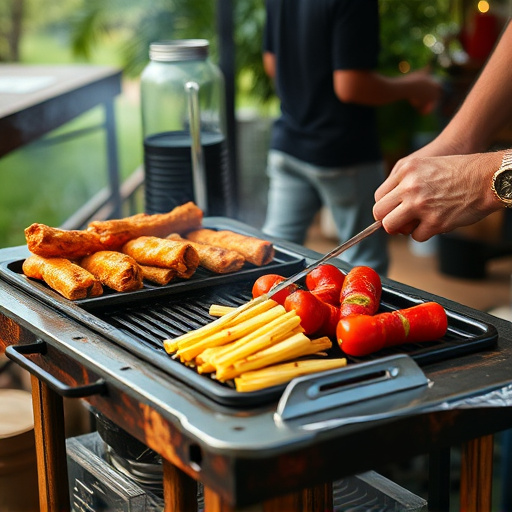Selecting high-quality beef brisket and mastering seasoning, smoking techniques, temperature control, and internal cooking times creates a perfect Smoked BBQ Brisket Recipe. Slice thinly across the grain and serve with sauces for a delightful experience.
“Unleash your inner BBQ master with a guide to crafting the perfect smoked brisket at home. This comprehensive journey takes you from selecting the ideal cut of meat to mastering low and slow cooking techniques. Learn how to season your brisket with a simple, effective rub, set up your smoker for optimal results, and perform crucial temperature checks. By following these steps, you’ll be serving up mouthwatering smoked BBQ brisket that’s sure to impress.”
- Choosing the Right Brisket Cut
- Seasoning the Meat: A Simple Rub
- Setting Up Your Smoker for Success
- Smoking Techniques and Temperatures
- The Art of Low and Slow Cooking
- Mastering Internal Temperature Checks
- Slicing and Serving Tips for Perfection
Choosing the Right Brisket Cut
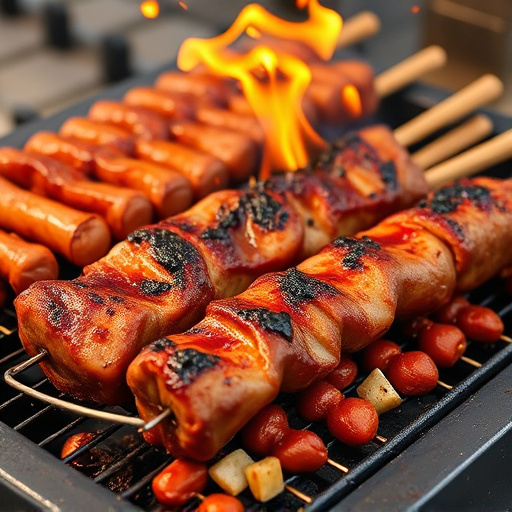
When it comes to smoking the perfect brisket, selecting the right cut is half the battle won. Opting for a high-quality, well-marbled beef brisket is key. Look for a packer-cut brisket, which has a thick layer of fat cap over the meat. This fat not only adds flavor but also helps to keep the brisket moist during the slow-smoking process. The point cut, with its intramuscular fat, is another excellent choice as it ensures even cooking and maximum juiciness.
For a truly exceptional smoked BBQ brisket recipe, consider starting with a whole packer brisket. This allows you to control the quality of the meat and trim it to your desired shape before smoking. Pre-trimming the brisket into two or three pieces (flat and point) can also help ensure even cooking, as different cuts have varying fat content and marbling.
Seasoning the Meat: A Simple Rub
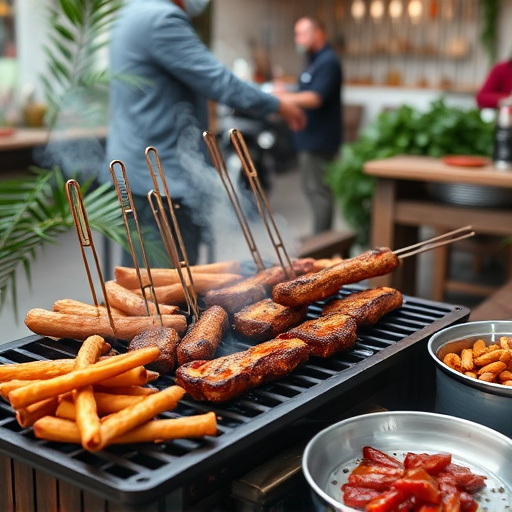
To achieve perfect smoked brisket at home, seasoning is key. A simple rub is all you need to enhance the natural flavors of this hearty cut of meat. For a classic BBQ brisket recipe, combine brown sugar, salt, pepper, garlic powder, paprika, and a touch of cayenne pepper. Adjust quantities to suit your taste preference—the sweeter notes of brown sugar balance the heat from spices, creating a delightful seasoning blend.
Apply the rub generously to both sides of the brisket, massaging it into the meat to ensure even distribution. This step is crucial for infusing flavor as the brisket smokes. Let the meat come to room temperature before smoking, and consider marinating it overnight for extra tenderization. Your smoked BBQ brisket recipe is now set to develop a rich, complex taste that will have your family and friends craving more.
Setting Up Your Smoker for Success
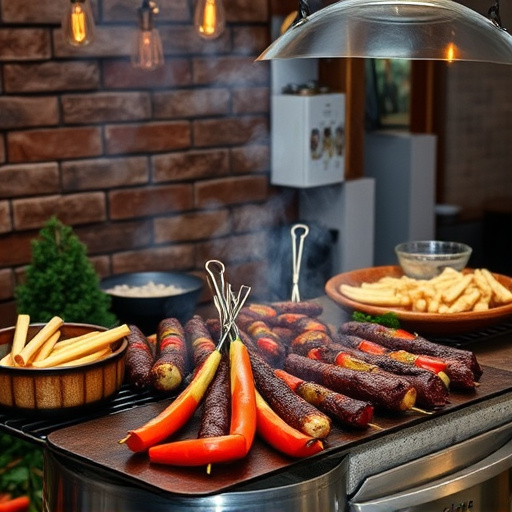
To achieve perfect smoked brisket at home, setting up your smoker is a crucial step. Start by selecting a reliable smoker that suits your needs—whether it’s a wood-fired pit, offset smoker, or electric model. Ensure it’s clean and well-maintained for optimal performance. The right temperature control is key; aim for a consistent 225°F to 250°F (107°C to 121°C) to gently cook the brisket over several hours. Load your smoker with hardwood chunks or pellets—mesquite, hickory, or oak are popular choices that impart a delicious smoky flavor to your BBQ brisket recipe.
Next, prepare your brisket by removing any silver skin and excess fat, leaving a thin layer for moisture and flavor. Season generously with a dry rub of salt, pepper, garlic powder, and paprika. Place the meat in the smoker, breast side up, and let it cook slowly. Keep an eye on the temperature and adjust as needed to ensure even cooking. The process may take 8-12 hours, but the reward is a tender, juicy smoked BBQ brisket that’s sure to impress.
Smoking Techniques and Temperatures
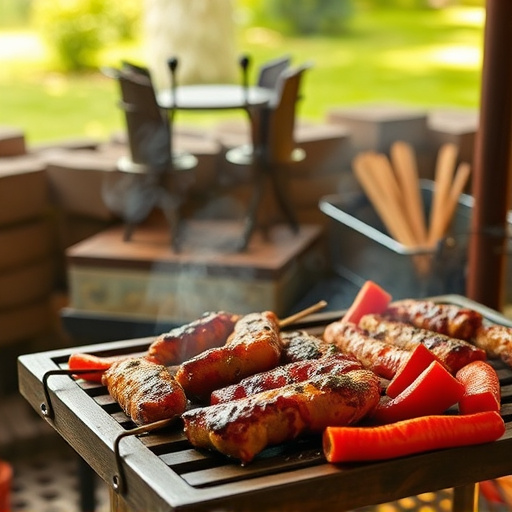
Smoking brisket is an art, and mastering it will result in a mouthwatering smoked BBQ brisket recipe that’s sure to impress. The key lies in understanding different smoking techniques and maintaining consistent temperatures. Typically, two methods are popular: hot smoking and cold smoking.
Hot smoking involves cooking the meat at high temperatures, around 225–250°F (107–121°C), using a wood fire. This method is ideal for brisket as it renders the fat and tenderizes the meat slowly. Cold smoking, on the other hand, uses low heat, often below 100°F (38°C), to preserve and add flavor over an extended period. It’s crucial to monitor the temperature and humidity during the process to ensure even cooking and prevent drying out the brisket. The right techniques and temperature control are fundamental to achieving that perfect, juicy smoked BBQ brisket recipe at home.
The Art of Low and Slow Cooking
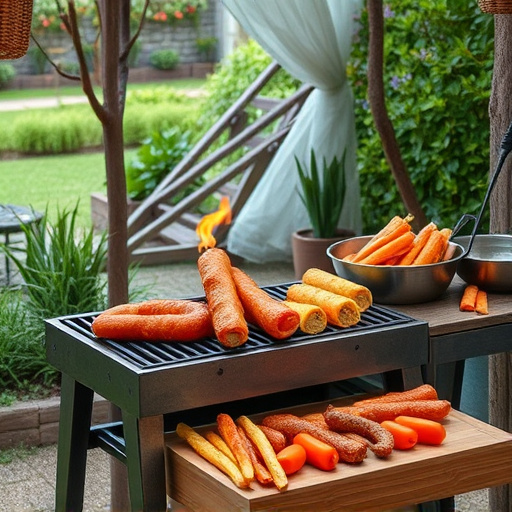
The art of smoking brisket lies in understanding the power of low and slow cooking. This method is a game-changer when it comes to achieving that perfect, tender, and juicy BBQ brisket recipe at home. By cooking at low temperatures for an extended period, you’re allowing the rich flavors to penetrate every fiber of the meat, resulting in a melt-in-your-mouth experience. It’s a patient process, but the end reward is well worth the wait.
Time and temperature are the key factors here. Typically, brisket is cooked at temperatures around 225°F (107°C) for about 1 to 1.5 hours per pound, ensuring it stays moist and avoids overcooking. This slow and steady approach transforms the tough cut of meat into a succulent treat, making it a favorite among BBQ enthusiasts.
Mastering Internal Temperature Checks
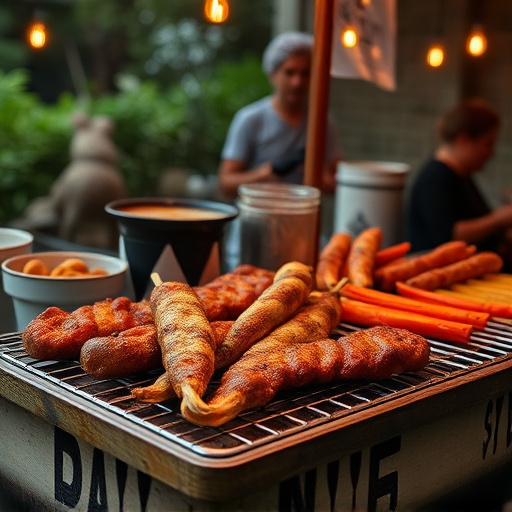
Mastering internal temperature checks is a crucial step in achieving perfection with your smoked BBQ brisket recipe. The key lies in understanding that different cuts and sizes of meat will require distinct cooking times to reach the ideal doneness. Invest in a reliable meat thermometer to monitor the internal temperature consistently. Aim for an internal temperature of 203°F (95°C) for prime, tender brisket. This ensures that the meat is cooked evenly, locking in juicy flavors without overcooking the tough, fibrous parts. Regular checks allow you to adjust your cooking strategy, preventing a dry or undercooked outcome.
As the brisket cooks, keep an eye on its color and texture changes. The meat should be tender and easily pull apart when prodded, with a beautiful, golden-brown crust. By combining visual cues with temperature readings, you can confidently navigate the cooking process, resulting in a mouthwatering smoked BBQ brisket recipe that will impress your taste buds.
Slicing and Serving Tips for Perfection
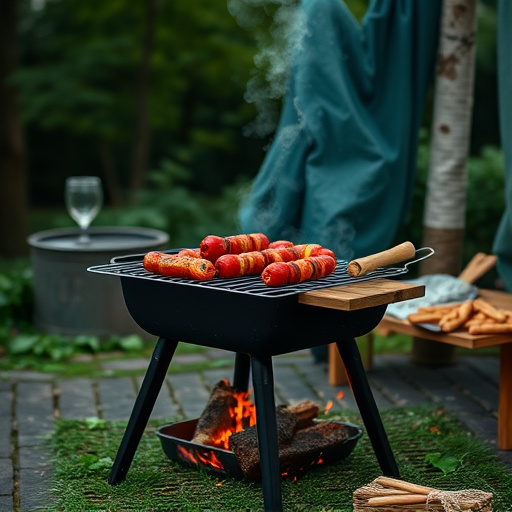
After slow-smoking your brisket to perfection, the next step is to slice it right to achieve maximum flavor and texture. Start by removing the point (the leaner top portion) from the flat (fattier bottom part). This separation ensures even cooking and allows for better presentation. Slice the brisket thinly across the grain—this makes it tender and easy to eat, with each slice capturing that tantalizing smoky flavor.
When serving your smoked BBQ brisket recipe, consider the traditional plate setup: stack slices on a bed of your favorite barbecue sauce, accompanied by creamy coleslaw or a rich au jus for dipping. The contrast of textures and flavors will make it a delightful experience for your taste buds!
